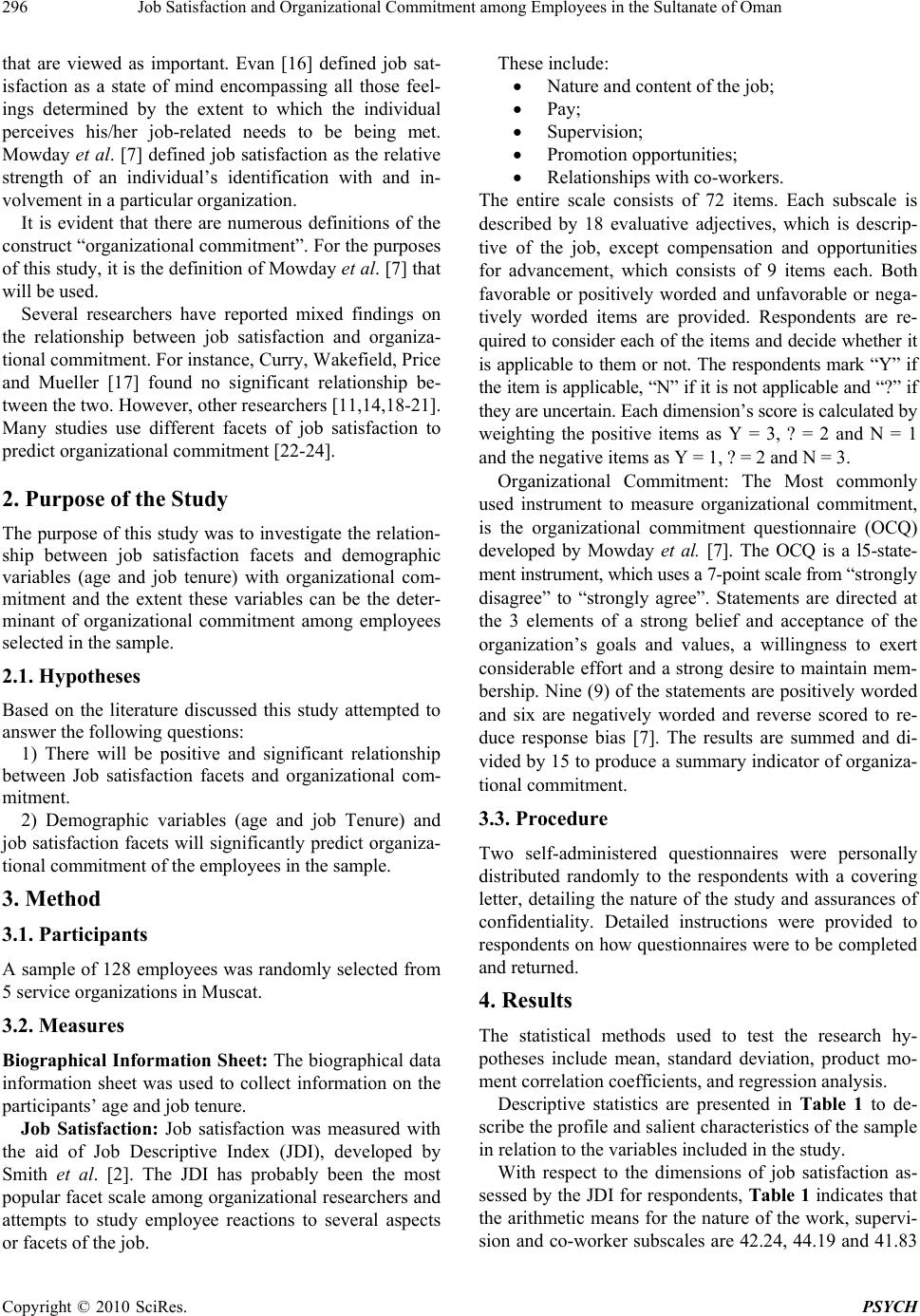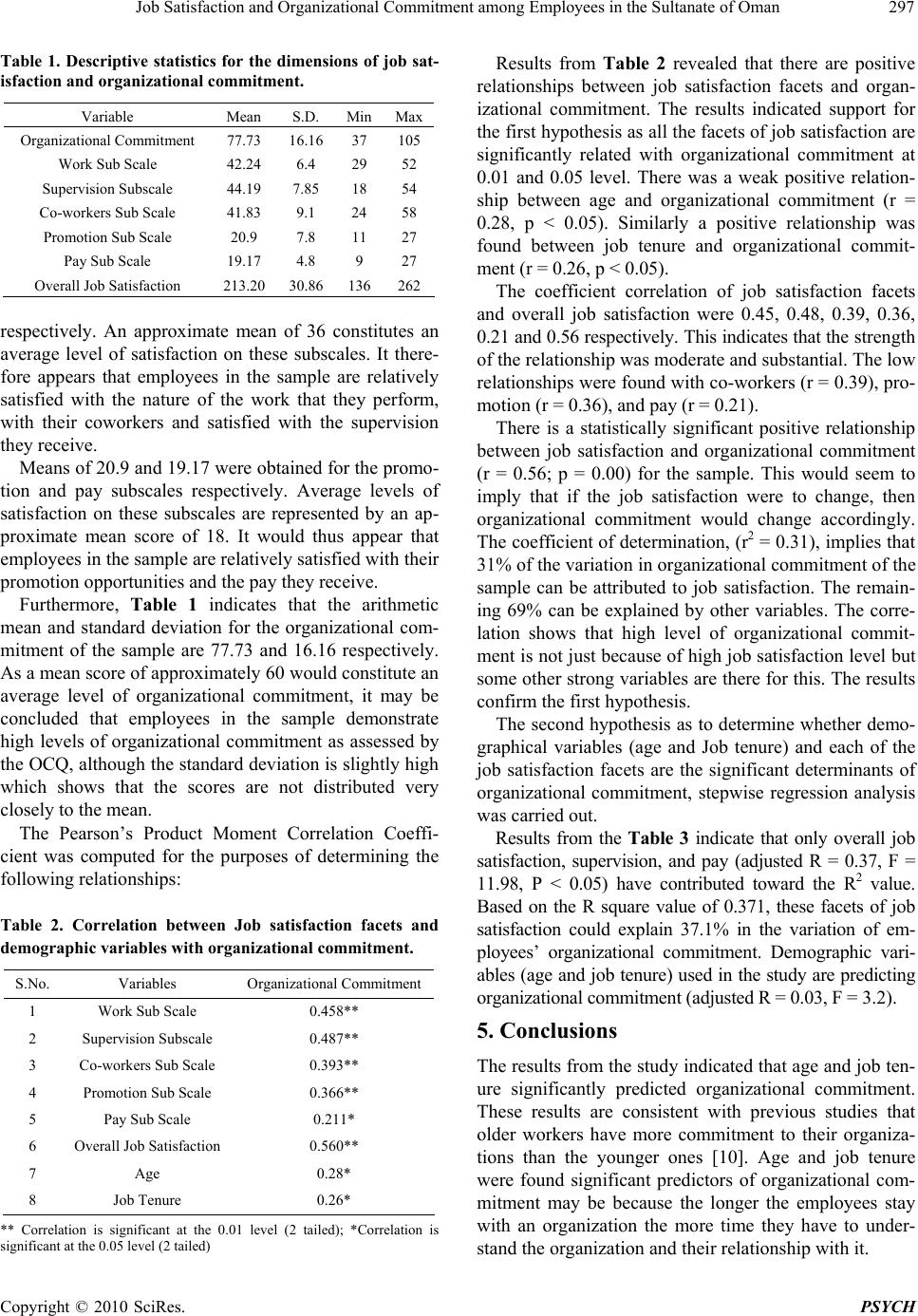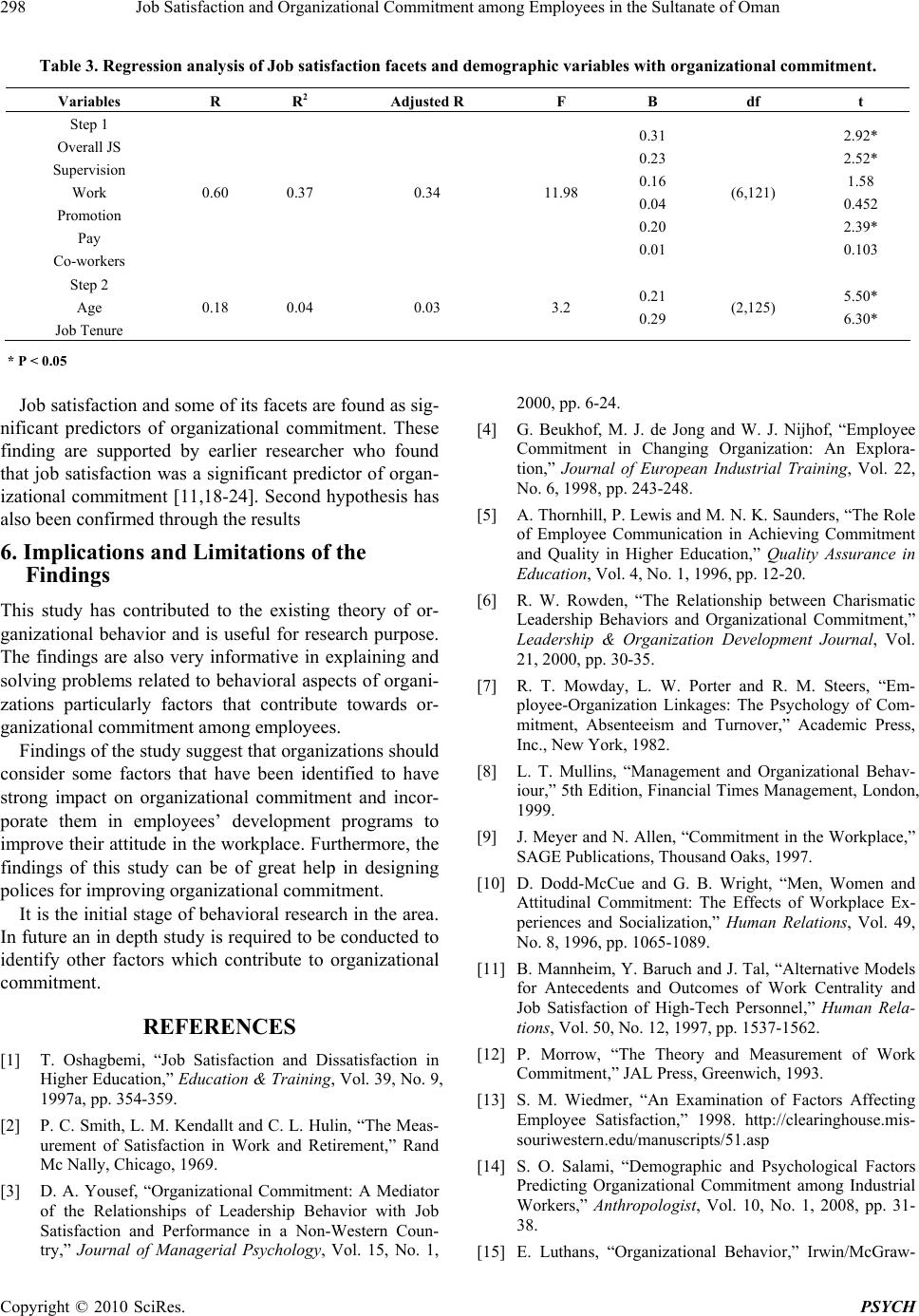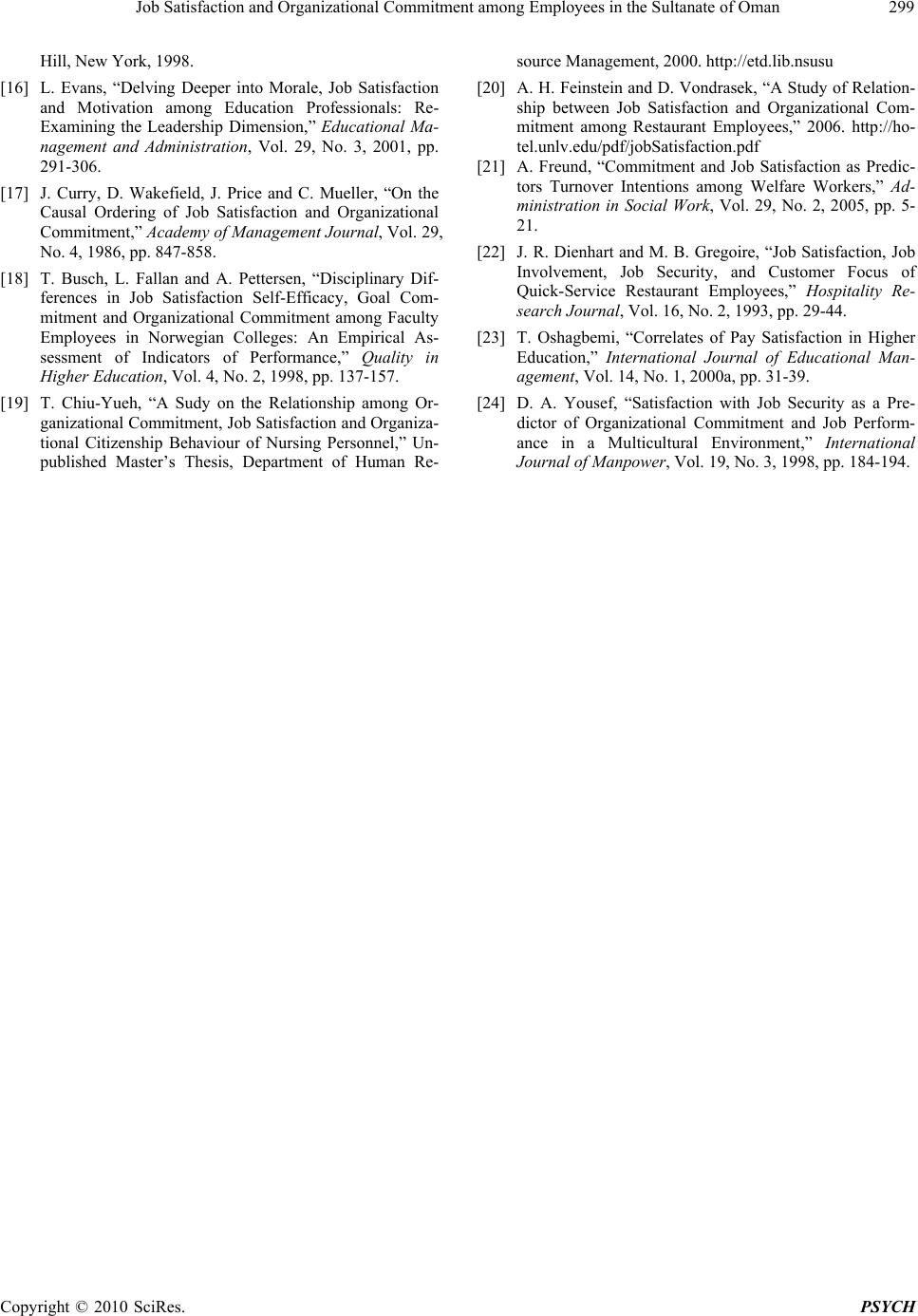Paper Menu >>
Journal Menu >>
 Psychology, 2010, 1, 295-299 doi:10.4236/psych.2010.14038 Published Online October 2010 (http://www.SciRP.org/journal/psych) Copyright © 2010 SciRes. PSYCH 295 Job Satisfaction and Organizational Commitment among Employees in the Sultanate of Oman Syed Mohammad Azeem Department of Management Information Systems, Yanbu University College, Yanbu, Saudi Arabia. Email: azeem_syed@hotmail.com Received August 9th, 2010; revised August 21st, 2010; accepted August 26th, 2010. ABSTRACT This study investigated the nature of relationships of demographic factors (age and job tenure) and job satisfaction facets with organizational commitment. The study also sought to determine the impact of demographic factors and job satisfaction facets on organizational commitment. A sample consists of 128 employees from service industry selected randomly. Employees were given a Job Descriptive Index (JDI) questionnaire and the Organizational Commitment questionnaire (OCQ). Pearson’s produ ct moment correlation coefficient a nd multiple regression analyses were used to analyze the data. The Results of the study show that the mean values of job satisfaction and organiza tional commitment are at moderate side. A moderate significant positive relationship was found among job satisfaction facets, demo- graphic factors, and organizational commitment. Supervision, pay, overall job satisfaction, age, and job tenure were the significant predictors of organizational commitment. Keywords: Job Satisfaction, Organizational Commitment, Correlation, Oman 1. Introduction Organizational commitment and job satisfaction are job related attitudes that have received considerable attentio n from researchers around the globe. This is because com- mitted and satisfied employees are normally high per- formers that contribute towards organizational produ ctiv- ity [1-3]. There are not much research efforts taken to explore attitudinal and behavioral aspects in the Sultanate of Oman. This study initiates an attempt to address this is- sue. This study is intended to examine the level of job satisfaction and organizational commitment among em- ployees in the selected organizations in Muscat, Oman. The success of an organization and the pursuit of qual- ity depend not only on how the organization makes the most of human competencies, but also on how it stimu- lates commitment to an organization [4,5]. Commitment has been related to valuable outcomes for both employ- ees and employers. Greater commitment can result in enhanced feelings of belonging, security, efficacy, greater career advancement, increased compensation and in- creased intrinsic rewards for the individual [6]. For the organization, the rewards of commitment can mean in- creased employee tenure, limited turnover, reduced train- ing costs, greater job satisfaction, acceptance of organi- zation’s demands, and the meeting of organizational goals such as high quality [7]. Different authors depending on their backgrounds have defined and measured organizational commitment differently. According to organizational commitment can be defined as an employee’s level of identification and involvement in the organization [8]. For Meyer and Al- lens organizational commitment is a psychological state that characterizes the employee’s relationship with the organization with its implications for the decision to con- tinue membership in the organization [9]. Mowday et al. defined organizational commitment as a strong belief in an organization’s goals, and values, a willingness to exert considerable effort on behalf of an organization and a strong desire to remain a member of the organization [7]. Demographic factors such as age, gender, marital status, education level and work experience have found to be significantly related to organizational commitment [10-13]. However, Salami found that age and job tenure are significant predictors of organizational commitment [14]. Luthans [15] defined job satisfaction as a pleasurable or positive emotion al state resulting from the appraisal of one’s job or job experience. It is a result of employee’s perception of how well their job provides those things  Job Satisfaction and Organizational Commitment among Employees in the Sultanate of Oman Copyright © 2010 SciRes. PSYCH 296 that are viewed as important. Evan [16] defined job sat- isfaction as a state of mind encompassing all those feel- ings determined by the extent to which the individual perceives his/her job-related needs to be being met. Mowday et al. [7] defined job satisfaction as the relative strength of an individual’s identification with and in- volvement in a particular organization. It is evident that there are numerous definitions of the construct “organizatio nal commitment”. For th e purposes of this study, it is the definition of Mowday et al. [7] that will be used. Several researchers have reported mixed findings on the relationship between job satisfaction and organiza- tional commitment. For instan ce, Curr y, W akef ield, Price and Mueller [17] found no significant relationship be- tween the two. However, other researchers [11,14,18-21]. Many studies use different facets of job satisfaction to predict organizational commitment [22-24]. 2. Purpose of the Study The purpose of this study was to investigate the relation- ship between job satisfaction facets and demographic variables (age and job tenure) with organizational com- mitment and the extent these variables can be the deter- minant of organizational commitment among employees selected in the sample. 2.1. Hypotheses Based on the literature discussed this study attempted to answer the following questions: 1) There will be positive and significant relationship between Job satisfaction facets and organizational com- mitment. 2) Demographic variables (age and job Tenure) and job satisfaction facets will significantly predict organiza- tional commitment of the employees in the sample. 3. Method 3.1. Participants A sample of 128 employees was randomly selected from 5 service organizations in Muscat. 3.2. Measures Biographical Information Sheet: The biographical data information sheet was used to collect information on the participants’ age and job tenure. Job Satisfaction: Job satisfaction was measured with the aid of Job Descriptive Index (JDI), developed by Smith et al. [2]. The JDI has probably been the most popular facet scale among organizational researchers and attempts to study employee reactions to several aspects or facets of the job. These include: Nature and content of the job; Pay; Supervision; Promotion opportunities; Relationships with co-w or ker s . The entire scale consists of 72 items. Each subscale is described by 18 evaluative adjectives, which is descrip- tive of the job, except compensation and opportunities for advancement, which consists of 9 items each. Both favorable or positively worded and unfavorable or nega- tively worded items are provided. Respondents are re- quired to consider each of the items and decide whether it is applicable to them or not. The respondents mark “Y” if the item is appl icable, “N” if it is no t applicable and “? ” if they are uncertain. Each dimension’s score is calculated by weighting the positive items as Y = 3, ? = 2 and N = 1 and the negative items as Y = 1, ? = 2 and N = 3. Organizational Commitment: The Most commonly used instrument to measure organizational commitment, is the organizational commitment questionnaire (OCQ) developed by Mowday et al. [7]. The OCQ is a l5-state- ment instrument, which uses a 7-point scale from “st rongly disagree” to “strongly agree”. Statements are directed at the 3 elements of a strong belief and acceptance of the organization’s goals and values, a willingness to exert considerable effort and a strong desire to maintain mem- bership. Nine (9) of the statements are positively worded and six are negatively worded and reverse scored to re- duce response bias [7]. The results are summed and di- vided by 15 to produce a summary indicator of organiza- tional commitment. 3.3. Procedure Two self-administered questionnaires were personally distributed randomly to the respondents with a covering letter, detailing the nature of the study and assurances of confidentiality. Detailed instructions were provided to respondents on how questionnaires were to be co mpleted and returned. 4. Results The statistical methods used to test the research hy- potheses include mean, standard deviation, product mo- ment correlation coefficients, and regression analysis. Descriptive statistics are presented in Table 1 to de- scribe the profile and salient characteristics of the sample in relation to the variables included in the stud y. With respect to the dimensions of job satisfaction as- sessed by the JDI for respondents, Table 1 indicates that the arithmetic means for the nature of the work, supervi- sion and co-worker subscales are 42.24, 44.19 and 41.83  Job Satisfaction and Organizational Commitment among Employees in the Sultanate of Oman Copyright © 2010 SciRes. PSYCH 297 Table 1. Descriptive statistics for the dimensions of job sat- isfaction and organizational commitment. Variable Mean S.D. MinMax Organizational Commitment 77.73 16.16 37 105 Work Sub Scale 42.24 6.4 29 52 Supervision Subscale 44.19 7.85 18 54 Co-workers Sub S ca l e 41.83 9.1 24 58 Promotion Sub Scale 20.9 7.8 11 27 Pay Sub Scale 19.17 4.8 9 27 Overall Job Satisfaction 213.20 30.86 136262 respectively. An approximate mean of 36 constitutes an average level of satisfaction on these subscales. It there- fore appears that employees in the sample are relatively satisfied with the nature of the work that they perform, with their coworkers and satisfied with the supervision they receive. Means of 20.9 and 19.17 were obtained for the promo- tion and pay subscales respectively. Average levels of satisfaction on these subscales are represented by an ap- proximate mean score of 18. It would thus appear that employees in the sample are relatively satisfied with their promotion opportunities and the pay they receive. Furthermore, Table 1 indicates that the arithmetic mean and standard deviation for the organizational com- mitment of the sample are 77.73 and 16.16 respectively. As a mean score of approximately 60 would constitu te an average level of organizational commitment, it may be concluded that employees in the sample demonstrate high levels of organizational commitment as assessed by the OCQ, although the standard deviation is sligh tly high which shows that the scores are not distributed very closely to the mean. The Pearson’s Product Moment Correlation Coeffi- cient was computed for the purposes of determining the following relationships: Table 2. Correlation between Job satisfaction facets and demographic variables with organizational commitment. S.No. Variables Organizational Commitment 1 Work Sub Scale 0.458** 2 Supervision Subscale 0.487** 3 Co-workers Sub S c al e 0.393** 4 Promotion Sub Scale 0.366** 5 Pay Sub Scale 0.211* 6 Overall Job Satisfaction 0.560** 7 Age 0.28* 8 Job Tenure 0.26* ** Correlation is significant at the 0.01 level (2 tailed); *Correlation is significant at the 0.05 level (2 tailed) Results from Table 2 revealed that there are positive relationships between job satisfaction facets and organ- izational commitment. The results indicated support for the first hypothesis as all the facets of job satisfaction are significantly related with organizational commitment at 0.01 and 0.05 level. There was a weak positive relation- ship between age and organizational commitment (r = 0.28, p < 0.05). Similarly a positive relationship was found between job tenure and organizational commit- ment (r = 0.26 , p < 0.05). The coefficient correlation of job satisfaction facets and overall job satisfaction were 0.45, 0.48, 0.39, 0.36, 0.21 and 0.56 respectively. This indicates that the stre ng th of the relationship was moderate and subs tantial. The low relationships were found with co-workers (r = 0.39), pro- motion (r = 0.36), and pay (r = 0.21). There is a statistically significant positive relationship between job satisfaction and organizational commitment (r = 0.56; p = 0.00) for the sample. This would seem to imply that if the job satisfaction were to change, then organizational commitment would change accordingly. The coefficient of determination, (r2 = 0.31), implies that 31% of the variation in organizational commitment of the sample can be attributed to job satisfaction. The remain- ing 69% can be explained by other variables. The corre- lation shows that high level of organizational commit- ment is not just because of high job satisfaction level but some other strong variables are there for this. The results confirm the first hypothesis. The second hypothesis as to determine whether demo- graphical variables (age and Job tenure) and each of the job satisfaction facets are the significant determinants of organizational commitment, stepwise regression analysis was carried out. Results from the Table 3 indicate that only overall job satisfaction, supervision, and pay (adjusted R = 0.37, F = 11.98, P < 0.05) have contributed toward the R2 value. Based on the R square value of 0.371, these facets of job satisfaction could explain 37.1% in the variation of em- ployees’ organizational commitment. Demographic vari- ables (age and job tenure) used in the study are predicting organizational commitment (adjusted R = 0.03, F = 3.2). 5. Conclusions The results from the study indicated that age and job ten- ure significantly predicted organizational commitment. These results are consistent with previous studies that older workers have more commitment to their organiza- tions than the younger ones [10]. Age and job tenure were found significant predictors of organizational com- mitment may be because the longer the employees stay with an organization the more time they have to under- stand the organization and th eir relationship with it.  Job Satisfaction and Organizational Commitment among Employees in the Sultanate of Oman Copyright © 2010 SciRes. PSYCH 298 Table 3. Regression analysis of Job satisfaction facets and demographic variables with organizational commitment. Variables R R2 Adjusted R F B df t Step 1 Overall JS Supervision Work Promotion Pay Co-workers 0.60 0.37 0.34 11.98 0.31 0.23 0.16 0.04 0.20 0.01 (6,121) 2.92* 2.52* 1.58 0.452 2.39* 0.103 Step 2 Age Job Tenure 0.18 0.04 0.03 3.2 0.21 0.29 (2,125) 5.50* 6.30* * P < 0.05 Job satisfaction and some of its facets are found as sig- nificant predictors of organizational commitment. These finding are supported by earlier researcher who found that job satisfaction was a significant predictor of organ- izational commitment [11,18-24]. Second hypothesis has also been confirmed through the results 6. Implications and Limitations of the Findings This study has contributed to the existing theory of or- ganizational behavior and is useful for research purpose. The findings are also very informative in explaining and solving problems related to behavioral aspects of organi- zations particularly factors that contribute towards or- ganizational commitment among employees. Findings of the study suggest that organizations should consider some factors that have been identified to have strong impact on organizational commitment and incor- porate them in employees’ development programs to improve their attitude in the workplace. Furthermore, the findings of this study can be of great help in designing polices for im pro vi n g or ganizational com mitment. It is the initial stage of behavioral research in the area. In future an in dep th study is required to be conducted to identify other factors which contribute to organizational commitment. REFERENCES [1] T. Oshagbemi, “Job Satisfaction and Dissatisfaction in Higher Education,” Education & Training, Vol. 39, No. 9, 1997a, pp. 354-359. [2] P. C. Smith, L. M. Kendallt and C. L. Hulin, “The Meas- urement of Satisfaction in Work and Retirement,” Rand Mc Nally, Chicago, 1969. [3] D. A. Yousef, “Organizational Commitment: A Mediator of the Relationships of Leadership Behavior with Job Satisfaction and Performance in a Non-Western Coun- try,” Journal of Managerial Psychology, Vol. 15, No. 1, 2000, pp. 6-24. [4] G. Beukhof, M. J. de Jong and W. J. Nijhof, “Employee Commitment in Changing Organization: An Explora- tion,” Journal of European Industrial Training, Vol. 22, No. 6, 1998, pp. 243-248. [5] A. Thornhill, P. Lewis and M. N. K. Saunders, “The Role of Employee Communication in Achieving Commitment and Quality in Higher Education,” Quality Assurance in Education, Vol. 4, No. 1, 1996, pp. 12-20. [6] R. W. Rowden, “The Relationship between Charismatic Leadership Behaviors and Organizational Commitment,” Leadership & Organization Development Journal, Vol. 21, 2000, pp. 30-35. [7] R. T. Mowday, L. W. Porter and R. M. Steers, “Em- ployee-Organization Linkages: The Psychology of Com- mitment, Absenteeism and Turnover,” Academic Press, Inc., New York, 1982. [8] L. T. Mullins, “Management and Organizational Behav- iour,” 5th Edition, Financial Times Management, London, 1999. [9] J. Meyer and N. Allen, “Commitment in the Workplace,” SAGE Publications, Thousand Oaks, 1997. [10] D. Dodd-McCue and G. B. Wright, “Men, Women and Attitudinal Commitment: The Effects of Workplace Ex- periences and Socialization,” Human Relations, Vol. 49, No. 8, 1996, pp. 1065-1089. [11] B. Mannheim, Y. Baruch and J. Tal, “Alternative Models for Antecedents and Outcomes of Work Centrality and Job Satisfaction of High-Tech Personnel,” Human Rela- tions, Vol. 50, No. 12, 1997, pp . 15 37- 156 2. [12] P. Morrow, “The Theory and Measurement of Work Commitment,” JAL Press, Greenwich, 1993. [13] S. M. Wiedmer, “An Examination of Factors Affecting Employee Satisfaction,” 1998. http://clearinghouse.mis- souriwestern.edu/manuscripts/51.asp [14] S. O. Salami, “Demographic and Psychological Factors Predicting Organizational Commitment among Industrial Workers,” Anthropologist, Vol. 10, No. 1, 2008, pp. 31- 38. [15] E. Luthans, “Organizational Behavior,” Irwin/McGraw-  Job Satisfaction and Organizational Commitment among Employees in the Sultanate of Oman Copyright © 2010 SciRes. PSYCH 299 Hill, New York, 1998. [16] L. Evans, “Delving Deeper into Morale, Job Satisfaction and Motivation among Education Professionals: Re- Examining the Leadership Dimension,” Educational Ma- nagement and Administration, Vol. 29, No. 3, 2001, pp. 291-306. [17] J. Curry, D. Wakefield, J. Price and C. Mueller, “On the Causal Ordering of Job Satisfaction and Organizational Commitment,” Academy of Management Journal, Vol. 29, No. 4, 1986, pp. 847-858. [18] T. Busch, L. Fallan and A. Pettersen, “Disciplinary Dif- ferences in Job Satisfaction Self-Efficacy, Goal Com- mitment and Organizational Commitment among Faculty Employees in Norwegian Colleges: An Empirical As- sessment of Indicators of Performance,” Quality in Higher Education, Vol. 4, No. 2, 1998, pp. 137-157. [19] T. Chiu-Yueh, “A Sudy on the Relationship among Or- ganizational Commitment, Job Satisfaction and Organiza- tional Citizenship Behaviour of Nursing Personnel,” Un- published Master’s Thesis, Department of Human Re- source Management, 2000. http://etd.lib.nsusu [20] A. H. Feinstein and D. Vondrasek, “A Study of Relation- ship between Job Satisfaction and Organizational Com- mitment among Restaurant Employees,” 2006. http://ho- tel.unlv.edu/pdf/jobSatisfaction.pdf [21] A. Freund, “Commitment and Job Satisfaction as Predic- tors Turnover Intentions among Welfare Workers,” Ad- ministration in Social Work, Vol. 29, No. 2, 2005, pp. 5- 21. [22] J. R. Dienhart and M. B. Gregoire, “Job Satisfaction, Job Involvement, Job Security, and Customer Focus of Quick-Service Restaurant Employees,” Hospitality Re- search Journal, Vol. 16, No. 2, 1993, pp. 29-44. [23] T. Oshagbemi, “Correlates of Pay Satisfaction in Higher Education,” International Journal of Educational Man- agement, Vol. 14, No. 1, 2000a, pp. 31-39. [24] D. A. Yousef, “Satisfaction with Job Security as a Pre- dictor of Organizational Commitment and Job Perform- ance in a Multicultural Environment,” International Journal of Manpower, Vol. 19, No. 3, 1998, pp. 184-194. |

